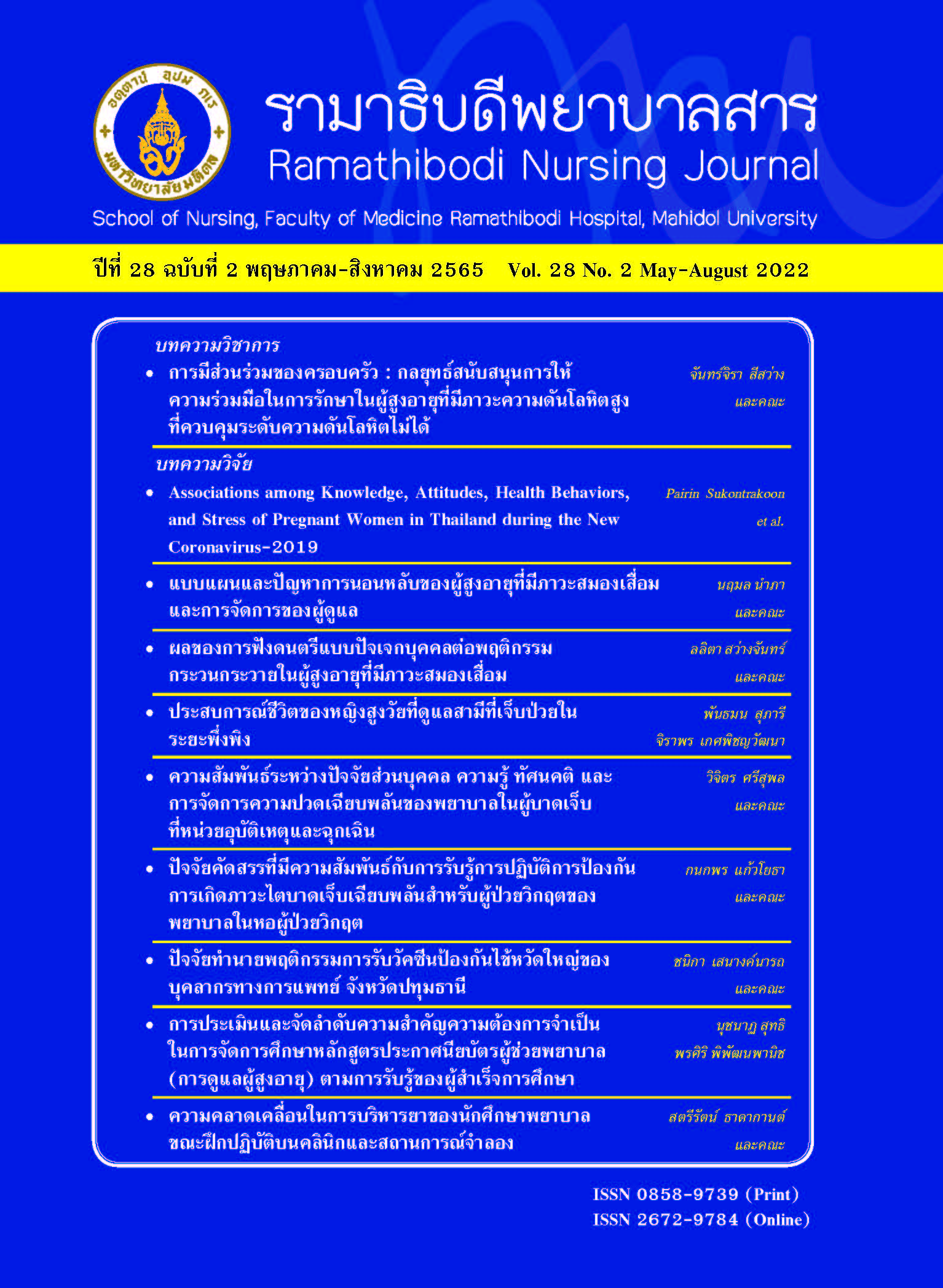Relationships Among Nurses’ Personal Factors, Knowledge, Attitudes, and Acute Pain Management for Trauma Patients in Emergency Department
Main Article Content
Abstract
This descriptive research aimed to explore relationships among nurses’personal factors, knowledge, and attitudes toward acute pain management, and acute pain management (APM) for trauma patients in the emergency department. Eighty-six professional nurses who worked in an emergency department and met the inclusion criteria were recruited for this study. The questionnaires were used to elicit demographic data, nurses’ knowledge about APM, nurses’ attitudes towards APM, nurses’ APM,and an assessment checklist on nurses’ APM. Data were analyzed using descriptive statistics, Spearman’s rank correlation coefficients, and point-biserial correlation
coefficients. The results demonstrated that the mean scores of nurses’ knowledge,attitudes, and APM for trauma patients in the emergency department were moderate,positive, and good, respectively. A moderate positive correlation was found between nurses’ knowledge and attitudes. Significant positive correlations were found between APM and nurses’ attitudes, years of working experience, and pain management training.However, nurses’ knowledge was not significantly correlated with APM. The findings could be used to develop clinical nursing practice guidelines for APM for trauma patients in the emergency department. Also, a regular APM training program should be provided for emergency nurses to improve nursing service quality.
Keywords: Knowledge, Attitude, Acute pain management, Trauma patient, Emergency nurses
Article Details

This work is licensed under a Creative Commons Attribution-NonCommercial-NoDerivatives 4.0 International License.
บทความ ข้อมูล เนื้อหา รูปภาพ ฯลฯ ที่ได้รับการตีพิมพ์ในรามาธิบดีพยาบาลสาร ถือเป็นลิขสิทธิ์ของวารสาร หากบุคคลหรือหน่วยงานใดต้องการนำทั้งหมดหรือส่วนหนึ่งส่วนใดไปเผยแพร่หรือเพื่อกระทำการใด ใด จะต้องได้รับอนุญาตเป็นลายลักษณ์อักษรจากรามาธิบดีพยาบาลสารก่อนเท่านั้น
References
Ridderikhof L., Schyns, FJ., Schep, NW, Lirk, P, Hollmann,MW, Goslings, JC. Emergency department pain management
in adult patients with traumatic injuries before and after implementation of a nurse-initiated pain treatment protocol
utilizing fentanyl for severe pain. J Emer Med. 2017;52(4):417-25.
Norasan S, Soonthornkul Na Cholburi J, Simai P. Trauma nursing. Nonthaburi, Beyond Enterprise; 2016. (in Thai)
Samcam I, Papa L. Acute pain management in the emergency department. Croatia: IntechOpen; 2016.
Srikaw B, Laosupap K. Pain management as reported by patients and nurses in an accident and emergency unit of
Nonkungsri Hospital. Research and Development Health System Journal. 2010;4(3):94-102. (in Thai)
Kamolwit S, Rattanapathumwong P. Development of clinical practice guidelines for pain management in postoperative
patients in Ranong hospital. Journal of Nursing Division.2014;41(2):23-40. (in Thai)
Thomas S. Management of pain in the emergency department.ISRN Emer Med J. 2013;(2013):1-19
Tsai F, Tsai Y, Chien C. Emergency nurses’ knowledge of perceived barriers in pain management in Taiwan. J Clin Nurs. 2007;16(11):2088-95.
Joane M, Drevdahl D. Nurses’ knowledge and attitudes toward pain in the emergency department. J Emer Nurs.2014;40(1):6-12.
Vuille M, Foerster M, Foucault E, Hugli O. Pain assessment by emergency nurses at triage in the emergency department:
a qualitative study. J Clin Nurs. 2018;27(3-4):669-76.
Katakorn P, Patoomwan A, Pookboonmee R. Nurses’knowledge, attitude, and nursing practices for pain management for postoperative children. Ramathibodi Nursing Journal. 2018;24(1):37-50. (in Thai)
Warina N, Nilmanat K, Mutchim Y. Selective factors related to intensive care units’ registered nurses’ competency in caring for terminally ill patients. Thai Journal of Nursing Council. 2018;32(4):94-106. (in Thai)
Sangkaew P, Jitpanya C. Relationships between knowledge,belief, experience, perceived barriers in pain management,
and nursing practice regarding pain management in post operation patients of registered nurses (master’s thesis).Chulalongkorn University; 2005. (in Thai)
Ngamkham S, Krutchan N, Sawangchai J, Wattanakul B,Chidnayee S, Kiewcha-um R. Knowledge about pain assessment and management of Thai nurses. Journal of Nursing and Health Care. 2018;36(1):81-9. (in Thai)
Panthong U, Khuwatsamrit K, Kanogsunthornrat N.Effects of pain education program on nurses’ knowledge and pain management in surgical critical patients. Journal of the Royal Thai Army Nurses. 2018;19(suppl1):403-11.(in Thai)
Bloom B. Taxonomy of educational objectives: the classification of educational goals; handbook. New York,David McKay; 1964.
Hozzacin S. Nurse’ knowledge and attitude, and pain management practice of post–operative children in Bangladesh
[thesis]. Songkla: Prince of Songkla University; 2010
Faul F, Erdfelder E, Buchner A, Lang A-G. Statistical power analyses using G* power 3.1: test for correlation and regression analysis. Behav Res Medthods. 2009;41:1149-60.
Moceri JT, Drevdahl DJ. Nurses’ knowledge and attitudes toward pain in the emergency department. J Emer Nurs.2014;40(1):6-12.
Kahsay DT, Pitkäjärvi M. Emergency nurses´ knowledge,attitude and perceived barriers regarding pain management
in resource-limited settings: cross-sectional study. BMC Nurs. 2019;18(1):56-68.
Stanley M, Pollard D. Relationship between knowledge,attitudes, and self-efficacy of nurses in the management of pediatric pain. Ped Nurs. 2013;39(4):165-71.
Bennetts S, Campbell-Brophy E, Huckson S, Doherty S,National Health and Medical Research Council’s National Institute for Clinical Studies National Emergency Care Pain Management Initiative. Pain management in Australian emergency departments: current practice, enablers, barriers and future directions. Emer Med Australia. 2012;24(2):136-43.
Thepsaw J, Payakkaraung S, Sanasuttipun W, Srichantaranit A. Relationship between knowledge, attitude, barriers,and nurses’ behavior in pediatric palliative care. Journal of Nursing Science. 2018;36(2):18-29. (in Thai)
Saephang C. Emergency nurses’ competency in pain management of traumatic patients and related factors(dissertation). Songkla: Prince of Songkla University;2017. (in Thai)
Benner P. From novice to expert. Am J Nurs. 1982;82(3):407-22.
Youngcharoen P, Catherine V, Chang P. Theory of planned behavior constructs associated with nurses’ pain assessment and
pro re nata (prn) opioid analgesic administration: a crosssectional study. Pain Manage Nurs. 2017;18(3):153-69.
Terasangchan T. Nurses’s knowledge, attitude, and pain management for postoperative elderly patients (master’sthesis). Songkla: Prince of Songkla University; 2006.(in Thai)


